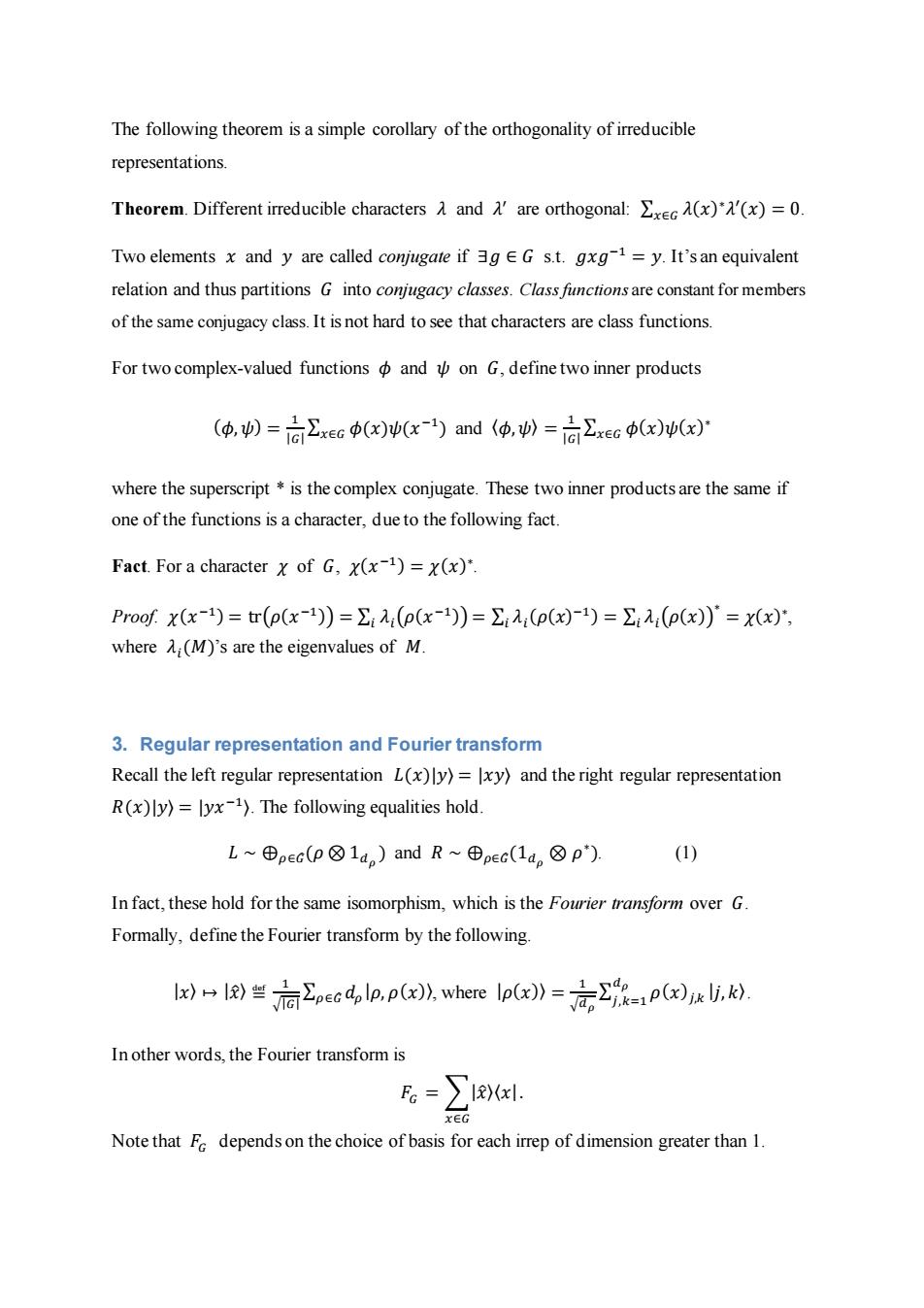正在加载图片...

The following theorem is a simple corollary of the orthogonality of irreducible representations. Theorem.Different irreducible characters and are orthogonal:xe(x)(x)=0. Two elements x and y are called conjugate if 3g EG s.t.gxg-1=y.It's an equivalent relation and thus partitions G into conjugacy classes.Class functions are constant for members of the same conjugacy class.It is not hard to see that characters are class functions. For two complex-valued functions and on G,define two inner products (,)=a2xe6()(x)and(0,0)=a26(x)(x) where the superscript is the complex conjugate.These two inner products are the same if one of the functions is a character,due to the following fact. Fact.For a character x of G,x(x1)=x(x)*. Proo时X(x-1)=tr(p(x-1)=::(p(x-1)=::(p(x)-1)=∑::(p(x)=x(x), where i(M)'s are the eigenvalues of M. 3.Regular representation and Fourier transform Recall the left regular representation L(x)ly)=Ixy)and the right regular representation R(x)ly)=lyx-1).The following equalities hold. L~⊕pec(p⑧1an)andR~⊕peG(1a,⑧p*), (1) In fact,these hold for the same isomorphism,which is the Fourier transform over G. Formally,define the Fourier transform by the following. lWH)兰a2p64lp,p,where》=忘2A=1p(r.k. In other words,the Fourier transform is E。=ex. XEG Note that F depends on the choice of basis for each irrep of dimension greater than 1.The following theorem is a simple corollary of the orthogonality of irreducible representations. Theorem. Different irreducible characters 𝜆 and 𝜆 ′ are orthogonal: ∑ 𝜆(𝑥) ∗𝜆′(𝑥) 𝑥∈𝐺 = 0. Two elements 𝑥 and 𝑦 are called conjugate if ∃𝑔 ∈ 𝐺 s.t. 𝑔𝑥𝑔−1 = 𝑦. It’s an equivalent relation and thus partitions 𝐺 into conjugacy classes. Class functions are constant for members of the same conjugacy class.It is not hard to see that characters are class functions. For two complex-valued functions 𝜙 and 𝜓 on 𝐺, define two inner products (𝜙, 𝜓) = 1 |𝐺| ∑ 𝜙(𝑥)𝜓(𝑥 −1 ) 𝑥∈𝐺 and 〈𝜙, 𝜓〉 = 1 |𝐺| ∑ 𝜙(𝑥)𝜓(𝑥) ∗ 𝑥∈𝐺 where the superscript * is the complex conjugate. These two inner products are the same if one of the functions is a character, due to the following fact. Fact. For a character 𝜒 of 𝐺, 𝜒(𝑥 −1 ) = 𝜒(𝑥) ∗ . Proof. 𝜒(𝑥 −1 ) = tr(𝜌(𝑥 −1 )) = ∑ 𝜆𝑖 (𝜌(𝑥 −1 )) 𝑖 = ∑ 𝜆𝑖 (𝜌(𝑥) −1 ) 𝑖 = ∑ 𝜆𝑖 (𝜌(𝑥)) ∗ 𝑖 = 𝜒(𝑥) ∗ , where 𝜆𝑖 (𝑀)’s are the eigenvalues of 𝑀. 3. Regular representation and Fourier transform Recall the left regular representation 𝐿(𝑥)|𝑦〉 = |𝑥𝑦〉 and the right regular representation 𝑅(𝑥)|𝑦〉 = |𝑦𝑥 −1 〉. The following equalities hold. 𝐿 ∼ ⨁ (𝜌 ⊗ 1𝑑𝜌 ) 𝜌∈𝐺̂ and 𝑅 ∼ ⨁ (1𝑑𝜌 ⊗ 𝜌 ∗ ) 𝜌∈𝐺̂ . (1) In fact, these hold for the same isomorphism, which is the Fourier transform over 𝐺. Formally, define the Fourier transform by the following. |𝑥〉 ↦ |𝑥̂〉 ≝ 1 √|𝐺| ∑ 𝑑𝜌 |𝜌, 𝜌(𝑥)〉 𝜌∈𝐺̂ , where |𝜌(𝑥)〉 = 1 √𝑑𝜌 ∑ 𝜌(𝑥) 𝑗,𝑘 𝑑𝜌 𝑗,𝑘=1 |𝑗, 𝑘〉. In other words, the Fourier transform is 𝐹𝐺 = ∑|𝑥̂〉〈𝑥| 𝑥∈𝐺 . Note that 𝐹𝐺 depends on the choice of basis for each irrep of dimension greater than 1